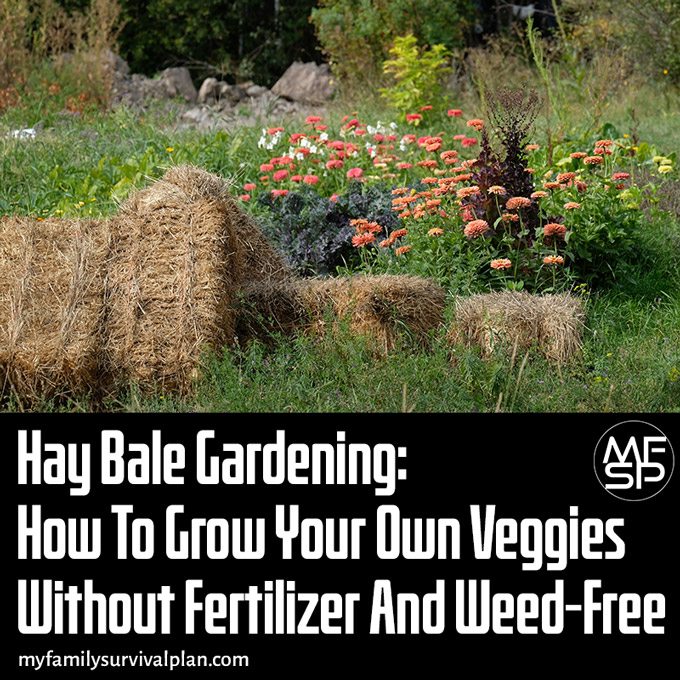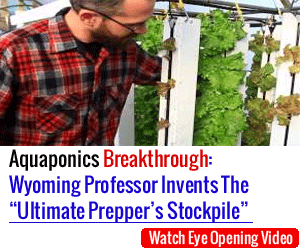Click Here To Join Our Telegram Channel for FREE daily tutorials!

Hay Bale Gardening: How To Grow Your Own Veggies Without Fertilizer And Weed-Free. Photo – Wikipedia – lic. under CC 2.0
I’ve been really into gardening lately, trying to find the best techniques and methods for growing fruit or veggies with as little effort or resources as possible. One method that really caught my attention was the straw bale method, a method that is based on planting into straw bales rather than in the ground. You prepare the bales thoroughly and that’s pretty much it. It’s cheap, requires very little care as the method is not pretentious at all and another bonus is that the plants are raised above ground level, which puts them out of the reach of various critters that could take a liking in whatever it is you planted. And not only that, picking the plants will from the straw bales, will be a lot easier than picking them from the ground. The seemed perfect, but only until I stumbled across the alternative: the HAY bale gardening method, which made the straw bale method seem less appealing all of a sudden.
Hay Bale Gardening vs. Straw Bale Gardening
For those of you who have very little to do with gardening, there is a major difference between the two. Straw bales are usually comprised of cereal crops stalks (corn, wheat, oat, rye, barley etc.). It’s mostly used for bedding livestock, and apart from carbon, it has no real nutritional value. It’s not inefficient as a surface for growing plants, but it will require regular watering and fertilizers to get the job done. Hay, on the other hand, it’s nothing but rich grasses that are mainly a source of rich and nutritious food for cattle during cold periods (winter time), when the fields are empty. They are filled with nutrients and minerals like nitrogen, potassium, phosphates etc. that vegetables require to grow. It’s exactly this natural cocktail of minerals and nutrients that require no additional fertilizing methods when it comes to hay bale gardening. Hay also holds water more efficiently than straw due to its density and chemical structure. So a hay bale garden requires watering once a day, whereas a straw bale garden will require watering 3 times a day.
Getting Started
The first thing you’ll need to start your very own hay bale garden is getting your hands on hay bales. If you have nobody to turn to in your vicinity that could sell or give you the hay bales, you can always go on the internet and find farmers that have hay bales for sale. Once they’re delivered to you, pick a spot to your liking (preferably in your garden) and set them as you see fit. Next, you’ll need to prepare the hay bales for the planting process. What’ll you’ll need is some 42-0-0 or even better, some nitrogen. You’ll treat the bales with nitrogen for 5 days; the nitrogen will break down bacteria, fungi, and insects into nutritious compost that will serve as “fuel” for your growing plants. If you’re not that keen on spending money on nitrogen or fertilizers, you can just pee on the hay bales for the 5-day period; pee is rich in nitrogen and it’ll get the job done just as efficiently. However, the daily dose of pee a person produces will not be enough for this endeavor, so I suggest you start saving your pee in bottles or containers.
The preparation of the bales will be done over a period of 10 days total before planting. In the uneven days, the bales will be treated with half-a-cup of nitrogen and sprayed with water. During the even days of the 10 day period, the bales will be watered only.
During this process, the temperature inside the hay bales will rise dramatically, most likely to 120°F – 140°F. Although is very unlikely that the bales will simply catch fire, the risk still exists. So water the bales regularly I order to avoid any unwanted incidents. When the “ordeal” is over, the temperature will subside, from how to warm. Once this happens, you can start planting your vegetables. Just add regular seeds, water the hay garden once a day and you’ll be able to pick the fruits of your labor in no time.
 Accurate temperature readings using a professional thermometer
Accurate temperature readings using a professional thermometer
Professional Tips
1. The bales should be tightly bound if you want them to hold. Synthetic twine works great and holds the hay bales together just fine during the growing season.
2. A single bale of hay will hold about two tomato plants, two pumpkin hill, 3 cauliflower plants or 3 broccoli plants; plants cover the same amount of space in the bales as they do in the ground.
3. Growing tall plants (sunflower, corn etc.) is not advised, as hay bales do not offer such plants the support they need. If you won’t provide these types of plants with a stacking system, they’ll most probably fall over.
4. You shouldn’t water the bales more than two times a day. There is no danger of drowning the plants because the water will evaporate quickly; the hay bales will not get drenched like soil would.
This method is very interesting and it seems to give great results even for the rookies. You don’t need much to get started. Just a minimum investment and the willpower to get things done. If you’re looking for a cheap and fast alternative to gardening, look no further: hay bale gardening is the way.
This Crazy Off Grid Device Literally Makes Drinkable Water From Fresh Air:
According to NASA, the U.S. is expecting a 100-YEAR LONG MEGADROUGHT.
It's already begun. Ask the farmers in California. They know.
Every survivalist knows that water is of critical importance. You NEED an independent water source that you can count on!
As an interesting "survival rehearsal" - imagine that you turned the tap on right now and nothing came out. How long would you last?
But what if there was another water source literally hidden in plain sight. That's right, I'm talking about the atmosphere!
The amazing thing about getting water from the natural moisture in the air... is that it is ALWAYS available.
This gives you real water security!
Learn more about how to tap into "Nature's secret water reservoir" and stay hydrated when TSHTF!
Watch the video:
😳 What Tinnitus Does To Your Brain Cells (And How To Stop It)
After 47 years of studies and countless brain scans done on more than 2,400 tinnitus patients, scientists at the MIT Institute found that in a shocking 96% of cases, tinnitus was actually shrinking their brain cells.
As it turns out, tinnitus and brain health are strongly linked.
Even more interesting: The reason why top army officials are not deaf after decades of hearing machine guns, bombs going off and helicopter noises…
Is because they are using something called "the wire method", a simple protocol inspired by a classified surgery on deaf people from the 1950s...

I Can't Help Showing This Off:
If you haven't heard of Claude Davis yet do yourself a huge favor and watch this video.
One of the smartest guys I ever had the pleasure of meeting, Claude set-up a unique prepping system that changed his life forever.
I already tried it myself and let me tell... you I was completely blown away... His surprising tactics could make your life easier and give you the peace of mind you deserve.
Don't just take my word for it... watch his short video and decide for yourself.

Most People Don't Have The Guts To Try This:
An amazing discovery in an abandoned house in Austin, Texas: A lost book of amazing survival knowledge, believed to have been long vanished to history, has been found in a dusty drawer in the house which belonged to a guy named Claude Davis.
Remember... back in those days, there was no electricity... no refrigerators... no law enforcement... and certainly no grocery store or supermarkets... Some of these exceptional skills are hundreds of years of old and they were learned the hard way by the early pioneers.
>> Click here to find out about them now
We've lost to history so much survival knowledge that we've become clueless compared to what our great grandfathers did or built on a daily basis to sustain their families.
Neighbors said that for the last couple of years Claude has tried to unearth and learn the forgotten ways of our great-grandparents and claimed to have found a secret of gargantuan proportions. A secret that he is about to reveal together with 3 old teachings that will change everything you think you know about preparedness:
>>> Click Here To Watch His Short Video <<<

More Off-Grid And Survival Resources:

What REALLY Happens When You Bury a Shipping Container? (Hint: It's A Bit Crazy...)
Shipping containers are all the rage - but if you are thinking about buying one, you MUST watch this video first:
There's a general belief that if you bury a shipping container you can create an awesome root cellar / storm shelter / survival bunker.
But is a shipping container strong enough to handle the pressure?
Watch the video to see what happens:
What Really Happens When You Bury a Shipping Container? (Click To Watch Video)












Hay is great, but prohibitively expensive down here in Cattle Friendly Texas so I use newspaper. Mine garden is a greenhouse so that helps preserve the paper longer, but either way it works. You have a very good website here and we have learned a lot from you. Thanks for all you do.